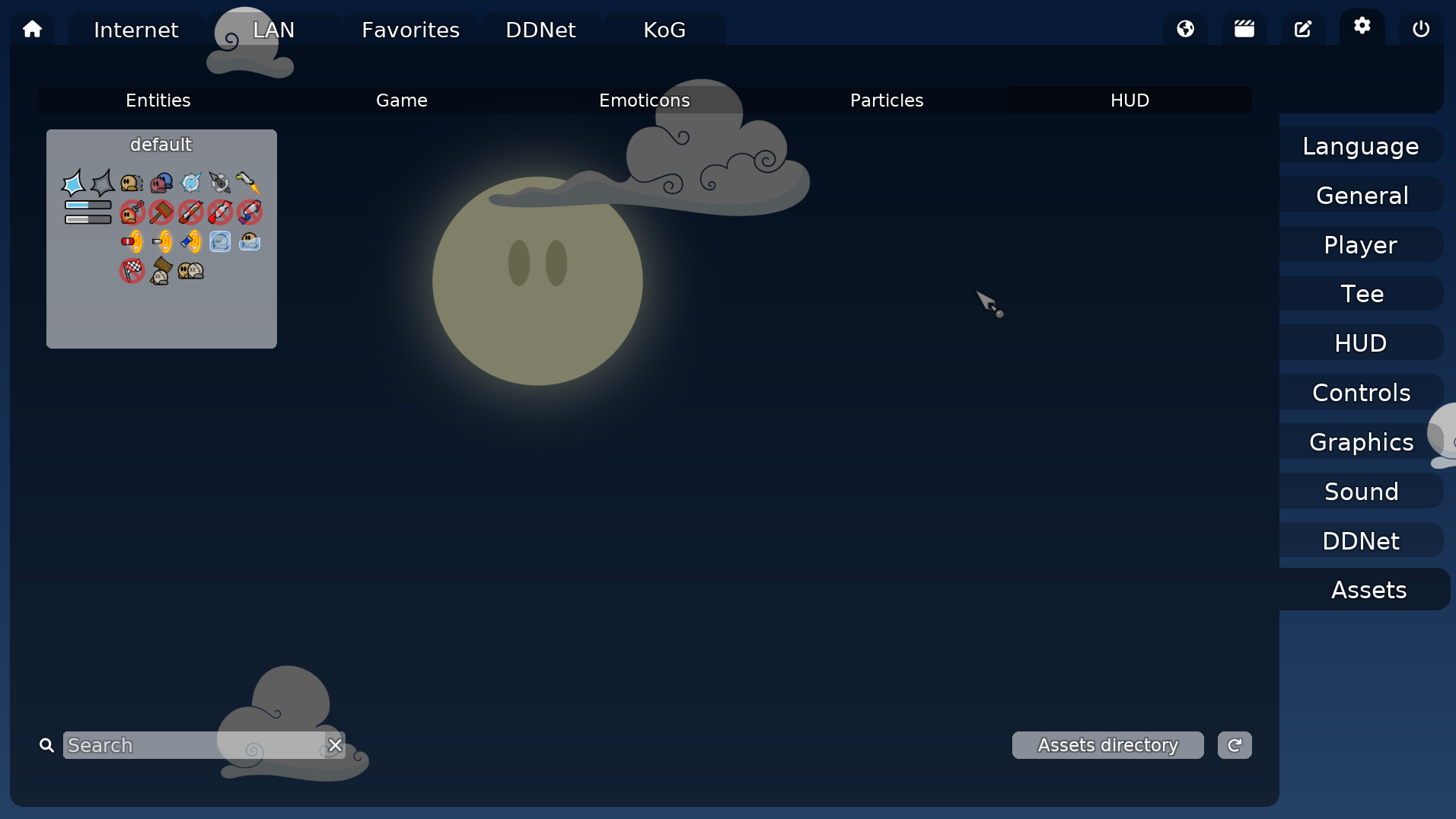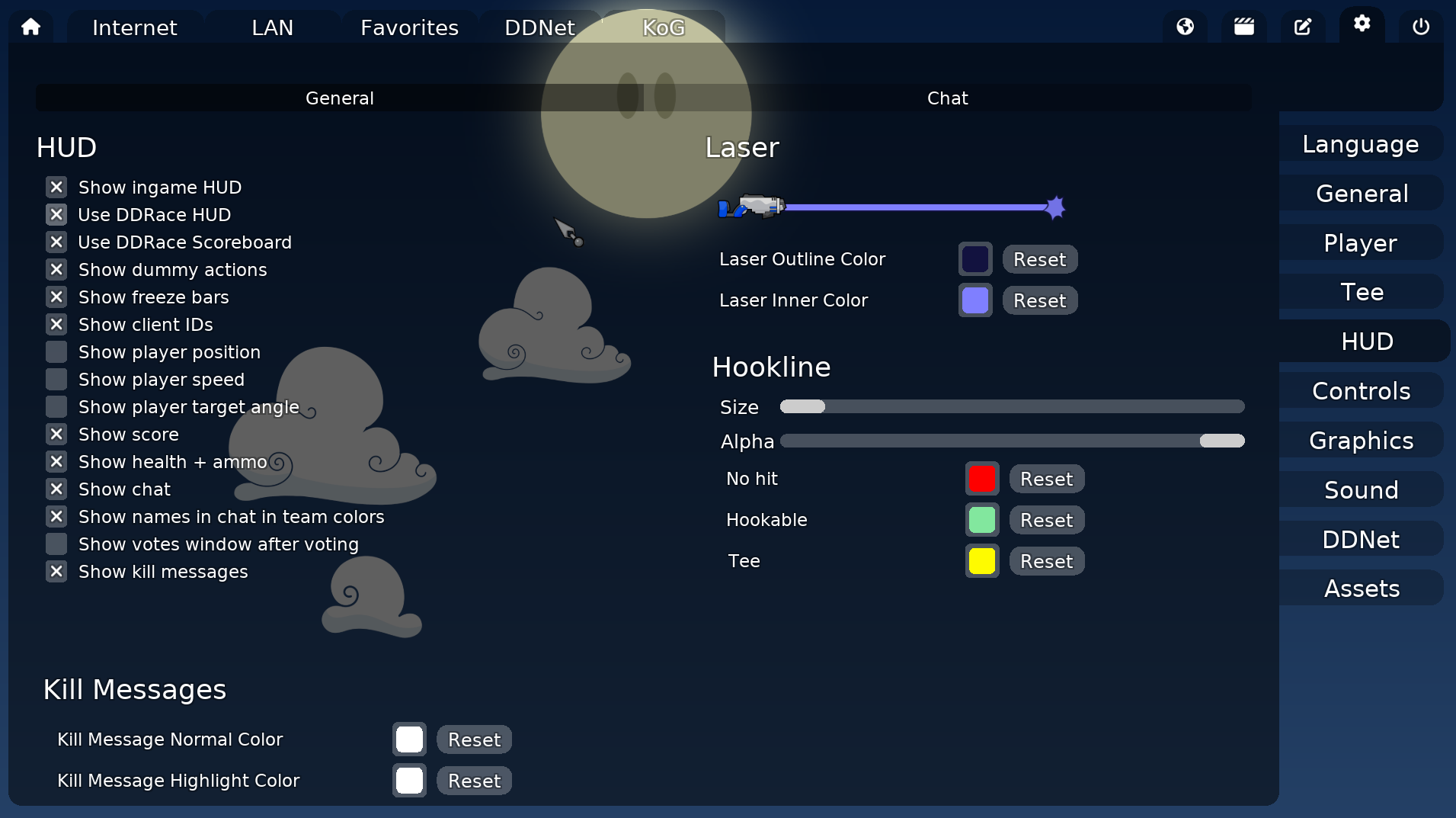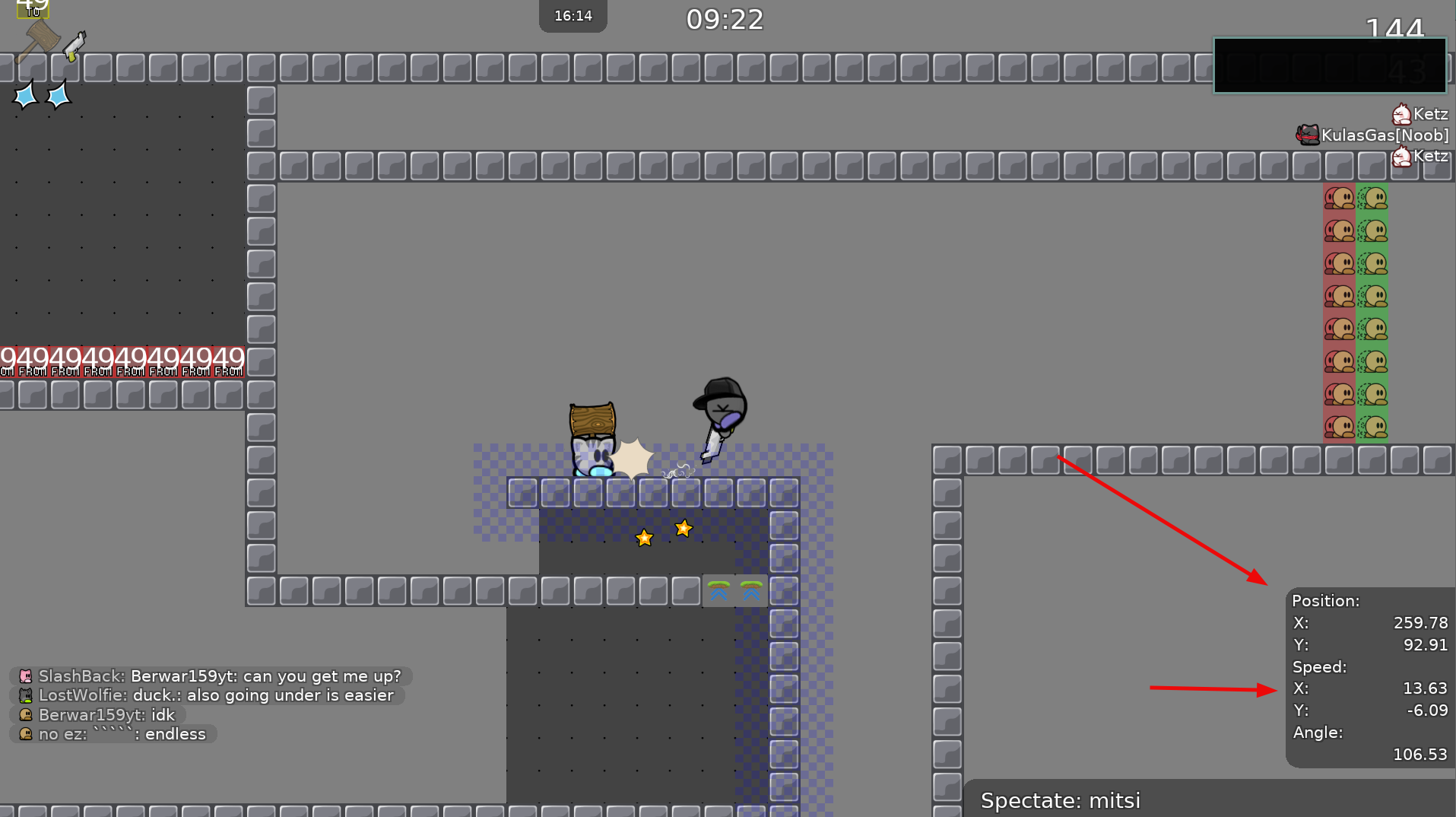Using `IClient::LocalTime` for smooth zooming in the editor causes the zoom to behave incorrectly when joining a game, as the local time is reset when joining a game.
This is fixed by adding a separate `IClient::GlobalTime` which is only set once when the client launches and never resets.
The variable `m_ResortServerBrowser` was only used in the client to pass it to the server browser. For better separation of concerns, this variable is moved inside `CServerBrowser` and the function `RequestResort` should be called to set it to `true`.
The existing variable `m_SortOnNextUpdate` is replaced with this, as it served the same purpose already. The variable name from upstream is used to reduce conflicts.
Fix warnings with `-fstrict-aliasing` and `-Wstrict-aliasing=2` by using char array instead of array of char pointers:
```
src/engine/client/client.cpp: In member function 'virtual const char* CClient::DemoPlayer_Play(const char*, int)':
src/engine/client/client.cpp:3858:123: warning: dereferencing type-punned pointer will break strict-aliasing rules [-Wstrict-aliasing]
3858 | m_aapSnapshots[g_Config.m_ClDummy][SNAP_CURRENT]->m_pSnap = (CSnapshot *)m_aaapDemorecSnapshotData[SNAP_CURRENT][0];
| ~~~~~~~~~~~~~~~~~~~~~~~~~~~~~~~~~~~~~~~~~^
src/engine/client/client.cpp:3859:126: warning: dereferencing type-punned pointer will break strict-aliasing rules [-Wstrict-aliasing]
3859 | m_aapSnapshots[g_Config.m_ClDummy][SNAP_CURRENT]->m_pAltSnap = (CSnapshot *)m_aaapDemorecSnapshotData[SNAP_CURRENT][1];
| ~~~~~~~~~~~~~~~~~~~~~~~~~~~~~~~~~~~~~~~~~^
src/engine/client/client.cpp:3864:117: warning: dereferencing type-punned pointer will break strict-aliasing rules [-Wstrict-aliasing]
3864 | m_aapSnapshots[g_Config.m_ClDummy][SNAP_PREV]->m_pSnap = (CSnapshot *)m_aaapDemorecSnapshotData[SNAP_PREV][0];
| ~~~~~~~~~~~~~~~~~~~~~~~~~~~~~~~~~~~~~~^
src/engine/client/client.cpp:3865:120: warning: dereferencing type-punned pointer will break strict-aliasing rules [-Wstrict-aliasing]
3865 | m_aapSnapshots[g_Config.m_ClDummy][SNAP_PREV]->m_pAltSnap = (CSnapshot *)m_aaapDemorecSnapshotData[SNAP_PREV][1];
| ~~~~~~~~~~~~~~~~~~~~~~~~~~~~~~~~~~~~~~^
```
Snapshot data during demo playback was being stored in an array of `char *` instead of an array of `char`, which caused above aliasing warnings and used 8 times more memory for the snapshot storage than being necessary.
This allows every game server to provide its own HTTPS server for map
downloads. Since the ingame protocol for downloading map data is very
inefficient, this is desirable. Previously, only servers hosted by DDNet
could benefit from this.
Security concerns:
- Attackers can find out whether a given HTTPS GET request matches a
known answer.
This isn't deemed to be problematic as no cookies for authentication
are sent and only the whole response can be matched.
- Sending requests to honeypot URLs to get people in legal trouble.
This seems to be already possible with HTML image embeds, so it can't
be that bad™.
- Downloading huge files, filling up a player's disk. The players might
cancel when seeing huge files.
There's a generous limit of 1 GiB per map file.
- Downloading huge files transparently compressed with gzip. See above.
Fixes#5812.
Make the member variables private and add `SetMin` to replace a usage of the member variables in `CDebugHud`. For completeness/symmetry, `SetMax` is also added.
The return value of `CGraph::InsertAt` was not checked. All uses of the function pass a correct index, so the return value is replaced with an assertion.
As the methods are always called at the same time, they can be combined. This also improves the performance, as the array only needs to be iterated once.
This allows the client to connect to servers that have both an IPv4 and
an IPv6 address, even if the client is only connected to one of the two.
The one faster to answer will be picked.
Timeout codes are now generated based on *all* of the server's
addresses.
Fixes#5158.
Support is incomplete for `leak_ip_address_to_all_servers` (will only
ping the first address of each server) and for the `leak_ip` setting
(which will also only ping the first address of each server).
Fix pointer and pointer array variable naming
Huge renaming to match our rules
Used regex: (?!(return|delete)\b)\b\w+ (m_|ms_|g_|gs_|s_)[^a]\w+\[
(?!(return|delete)\b)\b\w+ (?!(m_|ms_|g_|gs_|s_))[^a]\w+\[
Further format static variables
Format almost all pointer names accordingly
Used regex: (?!(return)\b)\b\w+
\*(?!(m_p|p|s_p|m_ap|s_ap|g_p|g_ap|ap|gs_ap|ms_ap|gs_p|ms_p))\w+\b[^:\(p]
clang-format
Fix CI fail
Fix misnamed non pointer as pointer and non array as array
Used regex: (?!(return|delete)\b)\b\w+ (m_|ms_|g_|gs_|s_)p\w+\b
(?!return\b)\b\w+ (ms_|m_|g_|gs_|s_)a\w+\b[^\[]
clang-format
Revert to SCREAMING_SNAKE_CASE and reinstate dead code
5486: Switch to loading screen, when map creation takes too long r=def- a=Jupeyy
Same as #4941
It doesn't directly fix the issue described in #5478, it does however not trigger it anymore. it's still a bug in our code unrelated to this. This just triggered the UB from the issue as `@ardadem` confirmed, SDL received a SDL_QUIT (`[2022-06-23 20:26:31][test]: sdl closed my client, but why xd`)
Now we have a confirmed case that making the window unresponsive can create weird behavior. Similar to the other pr switch to a loading screen after 500ms (this time without menu background map tho, since the menu background map calls the same code).
We really need some fancy loading screen for such situations, even tho they are rare xD
## Checklist
- [x] Tested the change ingame
- [ ] Provided screenshots if it is a visual change
- [ ] Tested in combination with possibly related configuration options
- [ ] Written a unit test if it works standalone, system.c especially
- [ ] Considered possible null pointers and out of bounds array indexing
- [ ] Changed no physics that affect existing maps
- [ ] Tested the change with [ASan+UBSan or valgrind's memcheck](https://github.com/ddnet/ddnet/#using-addresssanitizer--undefinedbehavioursanitizer-or-valgrinds-memcheck) (optional)
Co-authored-by: Jupeyy <jupjopjap@gmail.com>
Registering
-----------
The idea is that game servers push their server info to the
masterservers every 15 seconds or when the server info changes, but not
more than once per second.
The game servers do not support the old registering protocol anymore,
the backward compatibility is handled by the masterserver.
The register call is a HTTP POST to a URL like
`https://master1.ddnet.tw/ddnet/15/register` and looks like this:
```json
POST /ddnet/15/register HTTP/1.1
Address: tw-0.6+udp://connecting-address.invalid:8303
Secret: 81fa3955-6f83-4290-818d-31c0906b1118
Challenge-Secret: 81fa3955-6f83-4290-818d-31c0906b1118:tw0.6/ipv6
Info-Serial: 0
{
"max_clients": 64,
"max_players": 64,
"passworded": false,
"game_type": "TestDDraceNetwork",
"name": "My DDNet server",
"map": {
"name": "dm1",
"sha256": "0b0c481d77519c32fbe85624ef16ec0fa9991aec7367ad538bd280f28d8c26cf",
"size": 5805
},
"version": "0.6.4, 16.0.3",
"clients": []
}
```
The `Address` header declares that the server wants to register itself as
a `tw-0.6+udp` server, i.e. a server speaking a Teeworlds-0.6-compatible
protocol.
The free-form `Secret` header is used as a server identity, the server
list will be deduplicated via this secret.
The free-form `Challenge-Secret` is sent back via UDP for a port forward
check. This might have security implications as the masterserver can be
asked to send a UDP packet containing some user-controlled bytes. This
is somewhat mitigated by the fact that it can only go to an
attacker-controlled IP address.
The `Info-Serial` header is an integer field that should increase each
time the server info (in the body) changes. The masterserver uses that
field to ensure that it doesn't use old server infos.
The body is a free-form JSON object set by the game server. It should
contain certain keys in the correct form to be accepted by clients. The
body is optional if the masterserver already confirmed the reception of
the info with the given `Info-Serial`.
Not shown in this payload is the `Connless-Token` header that is used
for Teeworlds 0.7 style communication.
Also not shown is the `Challenge-Token` that should be included once the
server receives the challenge token via UDP.
The masterserver responds with a `200 OK` with a body like this:
```
{"status":"success"}
```
The `status` field can be `success` if the server was successfully
registered on the masterserver, `need_challenge` if the masterserver
wants the correct `Challenge-Token` header before the register process
is successful, `need_info` if the server sent an empty body but the
masterserver doesn't actually know the server info.
It can also be `error` if the request was malformed, only in this case
an HTTP status code except `200 OK` is sent.
Synchronization
---------------
The masterserver keeps state and outputs JSON files every second.
```json
{
"servers": [
{
"addresses": [
"tw-0.6+udp://127.0.0.1:8303",
"tw-0.6+udp://[::1]:8303"
],
"info_serial": 0,
"info": {
"max_clients": 64,
"max_players": 64,
"passworded": false,
"game_type": "TestDDraceNetwork",
"name": "My DDNet server",
"map": {
"name": "dm1",
"sha256": "0b0c481d77519c32fbe85624ef16ec0fa9991aec7367ad538bd280f28d8c26cf",
"size": 5805
},
"version": "0.6.4, 16.0.3",
"clients": []
}
}
]
}
```
`servers.json` (or configured by `--out`) is a server list that is
compatible with DDNet 15.5+ clients. It is a JSON object containing a
single key `servers` with a list of game servers. Each game server is
represented by a JSON object with an `addresses` key containing a list
of all known addresses of the server and an `info` key containing the
free-form server info sent by the game server. The free-form `info` JSON
object re-encoded by the master server and thus canonicalized and
stripped of any whitespace characters outside strings.
```json
{
"kind": "mastersrv",
"now": 1816002,
"secrets": {
"tw-0.6+udp://127.0.0.1:8303": {
"ping_time": 1811999,
"secret": "42d8f991-f2fa-46e5-a9ae-ebcc93846feb"
},
"tw-0.6+udp://[::1]:8303": {
"ping_time": 1811999,
"secret": "42d8f991-f2fa-46e5-a9ae-ebcc93846feb"
}
},
"servers": {
"42d8f991-f2fa-46e5-a9ae-ebcc93846feb": {
"info_serial": 0,
"info": {
"max_clients": 64,
"max_players": 64,
"passworded": false,
"game_type": "TestDDraceNetwork",
"name": "My DDNet server",
"map": {
"name": "dm1",
"sha256": "0b0c481d77519c32fbe85624ef16ec0fa9991aec7367ad538bd280f28d8c26cf",
"size": 5805
},
"version": "0.6.4, 16.0.3",
"clients": []
}
}
}
}
```
`--write-dump` outputs a JSON file compatible with `--read-dump-dir`,
this can be used to synchronize servers across different masterservers.
`--read-dump-dir` is also used to ingest servers from the backward
compatibility layer that pings each server for their server info using
the old protocol.
The `kind` field describe that this is `mastersrv` output and not from a
`backcompat`. This is used for prioritizing `mastersrv` information over
`backcompat` information.
The `now` field contains an integer describing the current time in
milliseconds relative an unspecified epoch that is fixed for each JSON
file. This is done instead of using the current time as the epoch for
better compression of non-changing data.
`secrets` is a map from each server address and to a JSON object
containing the last ping time (`ping_time`) in milliseconds relative to
the same epoch as before, and the server secret (`secret`) that is used
to unify server infos from different addresses of the same logical
server.
`servers` is a map from the aforementioned `secret`s to the
corresponding `info_serial` and `info`.
```json
[
"tw-0.6+udp://127.0.0.1:8303",
"tw-0.6+udp://[::1]:8303"
]
```
`--write-addresses` outputs a JSON file containing all addresses
corresponding to servers that are registered to HTTP masterservers. It
does not contain the servers that are obtained via backward
compatibility measures.
This file can be used by an old-style masterserver to also list
new-style servers without the game servers having to register there.
An implementation of this can be found at
https://github.com/heinrich5991/teeworlds/tree/mastersrv_6_backcompat
for Teeworlds 0.5/0.6 masterservers and at
https://github.com/heinrich5991/teeworlds/tree/mastersrv_7_backcompat
for Teeworlds 0.7 masterservers.
All these JSON files can be sent over the network in an efficient way
using https://github.com/heinrich5991/twmaster-collect. It establishes a
zstd-compressed TCP connection authenticated by a string token that is
sent in plain-text. It watches the specified file and transmits it every
time it changes. Due to the zstd-compression, the data sent over the
network is similar to the size of a diff.
Implementation
--------------
The masterserver implementation was done in Rust.
The current gameserver register implementation doesn't support more than
one masterserver for registering.
These diagnostics are supposed to guide the user to problem resolution.
They're displayed if no packet is received from the server within one
second of connecting.
No message if we don't have STUN servers.
"Trying to determine UDP connectivity..." if no answer has been received
from the STUN server yet and it hasn't timed out yet.
"UDP seems to be filtered." if the STUN request has timed out.
"UDP and TCP IP addresses seem to be different. Try disabling VPN,
proxy or network accelerators." if the STUN request has returned an IP
address different from the one obtained via HTTP from info2.ddnet.tw.
"No answer from server yet." otherwise, if the STUN request has returned
no interesting data, indicating that it's likely the game server's
fault.
5085: New DDRace HUD r=def- a=C0D3D3V
If you want to test this PR, you have to test it on a Server that includes this PR too.
Textures are made by Ravie
Here a showcase video with most parts shown: https://youtu.be/gPTVj-s3pgc
Added to the new HUD
- A display of the weapons available to the player
- The weapon the player is carrying is highlighted
- Indicators for the special abilities of the player (Endless Hook, Endless Jumps, Jetpack, Teleport Weapons)
- Indicators for abilities taken away from the player (Deep/Life Freeze, No Hook, No Weapons collision, No Collision)
- Control indicators for dummy controls (dummy hammer, dummy copy) (bottom right)
- Jump indicator (max 10 jumps ar displayed, and greyed out as soon as a jump is used)
- Ninja status bar that indicates how long a player is capable of using ninja (next to the ninja sword)
- Freeze status bar that indicates the thawing time of a player (below player)
- Movement Information can be displayed in a clean way above the mini score HUD (Position, Speed, Target Angle)
- Indicator if you are in practice mode
The complete HUD also works for players you spectate
I Added a new NetObj since the predicted values are not perfect and would make the display of the information a lot less good: DDNetCharacterDisplayInfo that contains the following information
```
NetIntRange("m_JumpedTotal", -2, 255),
NetTick("m_NinjaActivationTick"),
NetTick("m_FreezeTick"),
NetBool("m_IsInFreeze"),
NetBool("m_IsInPracticeMode"),
NetIntAny("m_TargetX"), # used for the Movement Information display
NetIntAny("m_TargetY"),
NetIntAny("m_RampValue"),
```
So if someone has an idea what data we could also need in the client for making the display more nice, now is the right moment to add more data to this network object.
A few screenshots:
Assets Tab:

HUD Settings:

Mini Debug HUD:

Speed.X is calculated using the players ramp vaule
## Checklist
- [x] Tested the change ingame
- [x] Provided screenshots if it is a visual change
- [ ] Tested in combination with possibly related configuration options
- [ ] Written a unit test if it works standalone, system.c especially
- [x] Considered possible null pointers and out of bounds array indexing
- [x] Changed no physics that affect existing maps
- [x] Tested the change with [ASan+UBSan or valgrind's memcheck](https://github.com/ddnet/ddnet/#using-addresssanitizer--undefinedbehavioursanitizer-or-valgrinds-memcheck) (optional)
Co-authored-by: c0d3d3v <c0d3d3v@mag-keinen-spam.de>
Co-authored-by: Jupeyy <jupjopjap@gmail.com>
- Added RenderMovementInformation() to the HUD
- Use m_Width instead of recalculating the display width each time in hud.cpp
- Reworked Debug HUD:
- Display velspeed.x*ramp and velspeed.y instead of velspeed*ramp
- Show unit of speed
- The graph for the velspeed.x*ramp behavior (if dbg_tuning is active) is now nicer and usable. A second graph zooming in on the turning point has been added.
- The velspeed.x*ramp graph will be redrawn only when new tuning parameters are added
- The target angle used to draw the tees is now calculated using the m_TargetX, m_TargetY in DDNetCharacterDisplayInfo if available.
- Added m_TargetX, m_TargetY and m_RampValue to DDNetCharacterDisplayInfo Snap (m_RampValue has a precision of one thousandth)
- Added CGraph::InsertAt() to create static Graphs
- Added "assets/hud" to initial created Directories
- Added Settings to hide Dummy Action HUD and Player Movement HUD cl_showhud_dummy_actions, cl_showhud_player_position, cl_showhud_player_speed, cl_showhud_player_angle
- Added Pointer to m_PrevExtendedDisplayInfo, for calculation of interpolated Angle in Player Rendering
- Added GetDigitsIndex(int Value, float Max); to hud.cpp
4768: Videorecorder on by default (also for github builds) r=Jupeyy a=def-
<!-- What is the motivation for the changes of this pull request -->
## Checklist
- [ ] Tested the change ingame
- [ ] Provided screenshots if it is a visual change
- [ ] Tested in combination with possibly related configuration options
- [ ] Written a unit test if it works standalone, system.c especially
- [ ] Considered possible null pointers and out of bounds array indexing
- [ ] Changed no physics that affect existing maps
- [ ] Tested the change with [ASan+UBSan or valgrind's memcheck](https://github.com/ddnet/ddnet/#using-addresssanitizer--undefinedbehavioursanitizer-or-valgrinds-memcheck) (optional)
Co-authored-by: Dennis Felsing <dennis@felsin9.de>
On the one hand variables called "Dummy" would tell us whether the
current action refers to the currently inactive tee ("dummy"). On the
other hand, these variables could tell us whether the current action
refers to the main connection to the server, or the secondary one. The
latter use case is now renamed to "Client", with the choices
`CLIENT_MAIN`, `CLIENT_DUMMY` (and `CLIENT_CONTACT`).
Perhaps better names could be found, especially since `Client` also
refers to the engine client class in the game code.
I tried to not fix bugs unless it would complicate the code.